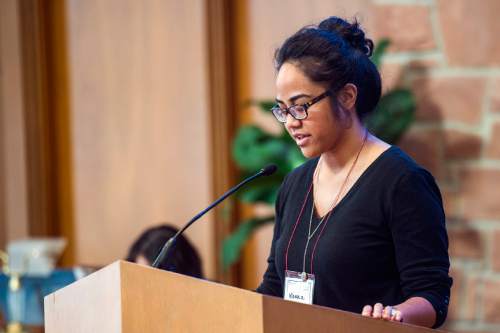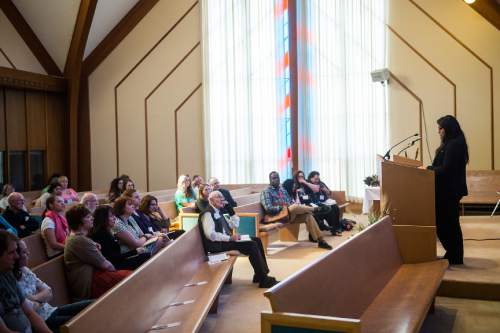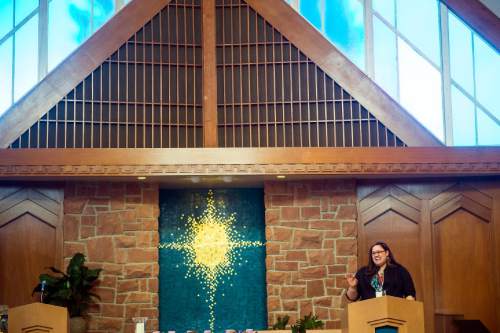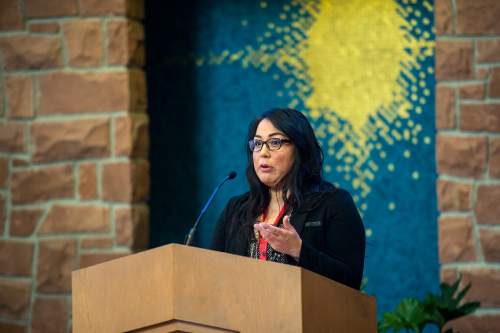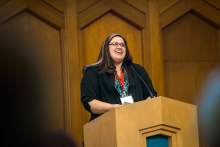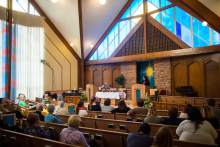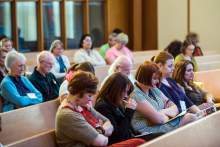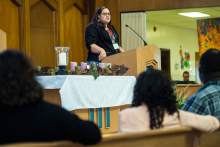This is an archived article that was published on sltrib.com in 2015, and information in the article may be outdated. It is provided only for personal research purposes and may not be reprinted.
They have been told their complexion would get whiter if they were righteous.
They have dealt with false and insulting assumptions about their intelligence and abilities. They have been labeled and excluded, rejected and isolated, judged and dismissed — and this by fellow believers.
Mostly, though, speakers at Saturday's Sunstone conference on "Theology From the Margins: What It Means to Be a Non-White Mormon in America" have felt invisible.
Growing up Mormon, conference organizer Lindsay Hansen Park acknowledged, "I envisioned white Heavenly Parents, white [male] bishops and white [female] Relief Society presidents."
Recently, Park told more than 70 people gathered at the Community of Christ Church in east Salt Lake City, she has been challenged to look beyond that image to the people, faces, experiences and history left out of the typical picture — people like Elise Boxer, whose father was a Dakota and whose mother was Chicano.
Boxer grew up in a small LDS branch on the Fort Peck Assiniboine and Sioux Reservation in Poplar, Mont.
Her Mormonism was "a reflection of the community," she said Saturday, which meant everyone in the congregation also was an American Indian.
Later, though, when the family moved to Yakama Nation Reservation, the majority of Latter-day Saints in her branch were white, Boxer said.
"I never felt I fully belonged," she said. "I was the only brown girl in any of my classes."
The LDS Church's unique scripture, the Book of Mormon, both "glorifies and condemns" the Lamanites, dark-skinned peoples believed by Latter-day Saints to be among the ancestors of American Indians, Boxer said, giving white Mormons a sense of "racialized superiority," and a sense that they were "saviors" to the indigenous people.
"My classmates did think we would become 'white' one day," she said, "and they commented a lot about our complexion."
In 1997, Boxer balked at commemorating the 150th anniversary of the Mormon pioneers entry into Utah in 1847 and the effort to push all LDS youths to participate.
"It was celebrating the history of the removal of my people," she said. "We have to critique how Mormons created the displacement of indigenous peoples."
After years of answering racist questions from fellow believers about her Indian identity, Boxer decided to examine the relationship between the LDS Church and indigenous peoples for her doctoral dissertation at Arizona State University.
Kalani Tonga, whose dad was Tongan and mom was Swedish, said hers is a life of opposites.
"I am an active Mormon and die-hard liberal feminist," Tonga, a single mom of five, said Saturday. "I am 'white and delightsome' and half Lamanite."
Growing up in Texas, the former volleyball player and history teacher said, she felt fine about the Lamanite label.
"We won the Book of Mormon," Tonga quipped.
She felt nurtured in the LDS community until one day as a teen, when her Young Women leader at church said, "God wants us to marry within our own race."
Tonga felt she would never be acceptable — she was biracial.
"It changed my outlook on who I was," she said, "and on eternal marriage."
After that, Tonga repeatedly got the message from some church members that she wasn't good enough, that she didn't matter.
But she does matter, she said, and so do words and actions of other members.
When Terrel Wyche, a 6 feet 8 inches tall black convert to The Church of Jesus Christ of Latter-day Saints originally from Charlotte, N.C., attended Brigham Young University, he was asked constantly if he was on a sports scholarship or what grades he had in high school or for his ACT scores.
Though Wyche graduated 10th in his class, the presumption was, he said, that he did not deserve to be at the LDS Church-owned school.
He loved his two-year Mormon mission to Brazil, he said, where he could "love and serve the people."
Upon returning to Provo, Wyche tried to follow his mission president's advice to find a wife, even though he knew that he was gay.
But the two women he dated both said, "I can't date you because you're black."
After that, he finished school but felt isolated from the Mormon community for being black and gay.
"It's like being passionately in love with someone who doesn't love you back," Wyche said. "I was heartbroken. The church didn't love me back."
Like several other speakers, Jennifer Gonzalez, an information designer, immigrant rights advocate and Stanford law graduate, has a dual heritage: Mexican American and German.
Gonzalez's white mother was disowned by her parents for marrying a "brown man," she said, and her father's mother died fairly early.
"I had no German grandmother to say, 'We are German.' " the activist said, "or a Mexican grandmother to say, 'We are Mexican.' "
She had to figure out an identity on her own.
At BYU, returned missionaries would compliment Gonzalez on her English — though she is a third-generation American.
Like Wyche, a man she fell in love with, said, "I can date you but could never bring a Mexican home to Idaho."
After living in both Washington, D.C., and the San Francisco Bay Area, Gonzalez has returned to Utah, where she is launching a nonprofit foundation to pioneer legal innovation in defense of domestic, human rights and social justice for vulnerable populations.
"Everything I know about God and the gospel," she said, "tells me this is what I am supposed to be doing."
BYU doctoral candidate Mica McGriggs said, "I, too, sing American. I, too, sing Mormon."
The biracial speaker then helped lead audience discussions of white privilege in the LDS Church and the consequences for the faithful.
The day concluded with a rousing sermon by Fatimah Salleh, a Mormon convert of 24 years who currently is working on a divinity degree at Duke University.
Salleh drew on the New Testament story of a Phoenician woman who asks Jesus' help with her daughter. When Christ said he was sent only to feed those in the House of Israel, she replies, " yet the dogs eat of the crumbs which fall from their masters' table."
The answer powerfully affected Jesus, who declared that she had "great faith."
Salleh compared the reaction of Christ's disciples, who wanted to send the woman away even as she cried, to the LDS Church, which turns away members on the margins.
"I am talking about the LGBT community, people of color or women who are asking for a part of God in their lives,"Salleh said. "We miss out when we try to only be the faith of the center."
Those on the margins, she said, have "great faith" and much to add to the body of Christ.
Twitter: @religiongal



